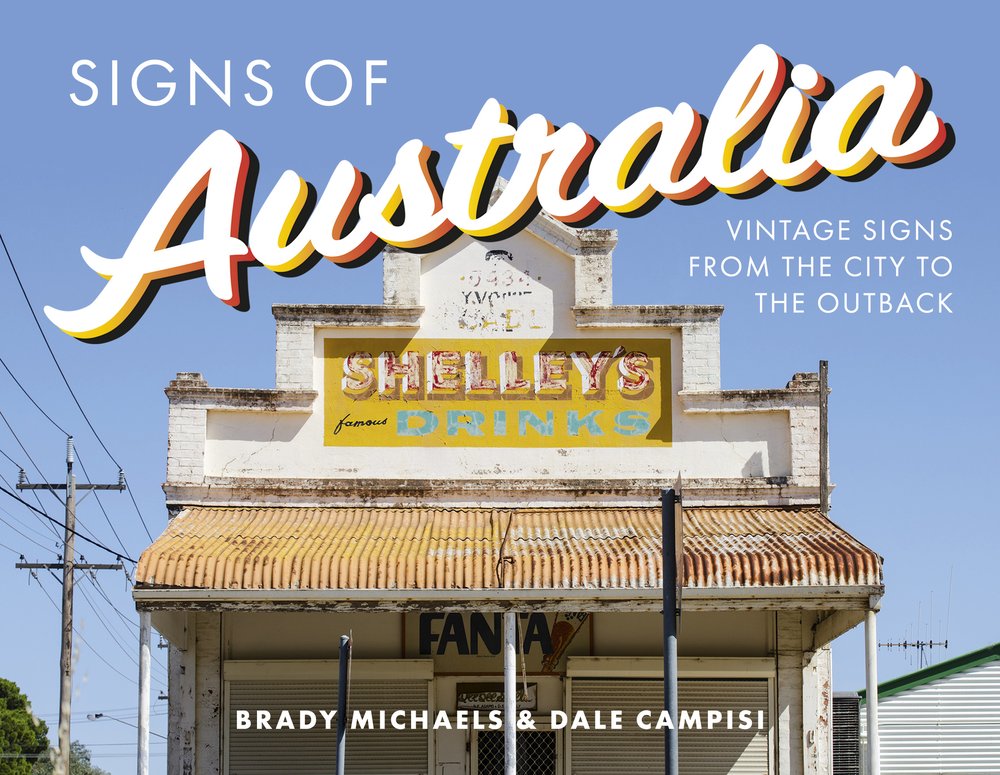Edited extract from the Introduction to Signs of Australia by Brady Michaels and Dale Campisi
Signs come and go. But the ones that remain are a visual record of Australian social history. They tell us who we are and how we got here, and they preserve a history of commercial sign writing and typography too.
We’ve been looking for Australia’s vintage signs for about a decade. It started with a couple of Melbourne icons: Skipping Girl, a top-hatted pig and the Nylex Clock. We knew there must be signs like these all over Australia and we wanted to see them.
So we set off on a road trip around the country. In our search for vintage signs we drove more than 40,000 kilometres and visited thousands of villages, towns and cities in all eight of Australia’s states and territories.
We didn’t always know what we’d find or even where to look. But sure enough, there they were: a beer-drinking emu in outback Queensland; an entire shed advertising Dr Morse’s Indian Root Pills in a paddock on the outskirts of Maitland; the gothic-script neon masthead for the West Australian newspaper that now adorns a wall at a Bob Hawke-themed bar in Perth; a four storey dingo on the side of an old flour mill in Fremantle.
Some of the signs included in this book are not all that old. Some are even still in use, faded and broken though they may be. Most are what sign hunters know as ghost signs: often ads for old brands and products like Velvet Soap, Resch’s Lager, Kalgoorlie Bitter and myriad local soft drink companies. They belong primarily to the advertising age before the internet.
The term ‘ghost sign’ most commonly refers to hand-painted signs on brick walls – the work of sign writers. Sign writing has become a niche art, having largely been replaced by printed decals. In the pro-cess, advertising’s production has been made quicker and more efficient, but it has lost its handmade quality.
Sign writing, though, is a hard job that requires a steady hand while working on large-scale, generally imperfect surfaces. It takes physical stamina, too, to maintain precision while working long hours, often up a ladder.
There are ghost signs in every town in Australia. We walk and drive past them every day. But unless you’re looking out for them, you might not even notice they’re there – a product of our ability to filter out irrelevant visual ‘noise’.
Some ghost signs are just a shadow of their former selves, visible only in the right light or weather and from a certain vantage point. Like the ad for Zebra stove polish painted high on a sandstone wall in Hobart, perhaps best viewed from the front bar of the pub across the road.
We quickly found that all these old signs have stories. The many ads for Bushells reveals Australia’s love affair with tea. Find one of these and you might also spot one for Robur nearby, which points to the tea war once waged on suburban streets. Only one remains a household name.
Ghost signs won’t be around forever. They’re rarely if ever heritage listed and are under constant threat from demolition. But although real estate development threatens historic signs, sometimes it saves them. As we saw from Fitzroy to Fremantle, warehouse and factory conversions have celebrated historic signs as a unique selling point.
Sometimes, ghost signs reappear during building demolitions as if by magic. This is known as a reveal. Like a window into the past, these signs are highly prized to see and record before they are built out once more.
We found a great example in the Perth suburb of Maylands, revealed during demolition work in 2016. The developer of the site enjoyed seeing people stopping to take photos of the sign, and was even inspired to research the business behind it. He discovered a link to the mining magnate Lang Hancock, and a clever slogan designed to help people remem-ber the business’s phone number. But he also said the sign couldn’t be saved, remarking that this reveal ‘is only a gift for a little while’.
…
This book is a selection of some of our favourite signs, from the well-known and perfectly preserved to the neglected and long forgotten. It‘s also a celebration of typography, design, advertising and the makers of these signs, past and present. The signs of Australia are full of local character and regional flavour and we hope you enjoy looking at them as much as we did finding them. We look forward to finding more.
Dale Campisi and Brady Michael’s book Signs of Australia is published by NewSouth in November 2017.



